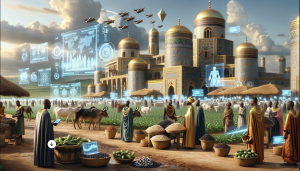Era and Setting: In the heart of a reimagined 16th century West Africa, the legacy of King Mansa Musa’s opulence lives on, but with a twist that artfully blends the rich history of the region with a visionary future of human-AI interaction.
Environment: This fictional world I created, is deeply rooted in the cultural bedrock of the past, it offers a vivid tableau of bustling markets under Moorish-inspired architecture, where the echoes of ancestral wisdom harmonize with the hum of advanced technology.
Food and Culture: The cuisine is a mosaic of tradition and innovation. Locusts, a major protein source, and shea butter, pivotal in both cooking and skincare, hint at the resilience and adaptability of this society. Amidst the three-horned livestock (a delightful divergence from our world), the people trade using cowrie shells, preserving the ancient currency of their ancestors while engaging with holographic displays that flicker above the marketplace like modern-day tapestries woven with light.
Economy: Here, the economy thrives on a unique barter system that underscores the importance of community and personal interaction, a stark contrast to the impersonal transactions often associated with futuristic economies. It’s a world where gold doesn’t just signify wealth but weaves itself into the very fabric of daily life, from the clothing to the stunning architecture, reminding us of the region’s historical grandeur.
Religion and Education: Religion and education form the twin pillars of this society, with universities flaunting Moorish elegance and a populace fluent in Arabic and English. This land houses the famous TIMBUKTU. The daily prayers resonate with the same devotion as they did centuries ago, yet the golden attire of the people reflects a society where wealth is abundant, and knowledge revered.
In this world I created, AI doesn’t detract from religious practice; instead, it offers a conduit for deeper reflection and understanding, bridging the gap between faith and progress.
Technology: Technological advancements are most poignantly observed in human-AI interactions. Large screens facilitate communication beyond borders with simple hand gestures, symbolizing a world where technology empowers, rather than isolates. AI here isn’t just a tool but a partner in maintaining the delicate balance between progress and tradition. It’s a testament to a society that values the augmentation of human capability without losing sight of its heritage.
Uniqueness: This visionary world’s uniqueness lies in its harmonious juxtaposition of the old and the new. The constant abundance of harvests hints at a society that has mastered the art of sustainability, likely aided by AI that optimizes agricultural processes while respecting the natural environment. The result is a civilization where technology doesn’t eclipse tradition but rather enhances it, allowing for a flourishing of culture, education, and spirituality.
As I reflect on the future of human-AI relationships within this imaginative realm, it becomes apparent that such a synergy can foster a society that neither rejects its past nor blindly rushes into the future. Instead, it cherishes its history while embracing the possibilities that AI brings. This world serves as a canvas, inviting us to envision a future where technology and humanity are not at odds but in concert, crafting a melody that resonates with the harmony of a society that honors where it has been as it embarks on the journey to where it will go.
In creating such a world, I am reminded of the boundless potential that lies in the interplay of human creativity and artificial intelligence, a dance of possibilities that could very well inform our own trajectory in the years to come.